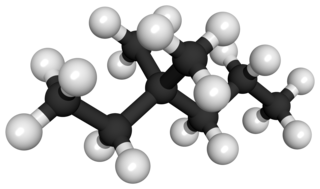Hentriacontane, also called untriacontane, is a solid, long-chain alkane hydrocarbon with the structural formula CH3(CH2)29CH3. It is the main component of Paraffin wax.

2-Methylheptane is a branched-chain alkane and an isomer of octane. It is an heptane molecule with a methyl group attached to its second atom. It is a flammable colorless liquid used as fuel.

Ampyrone is a metabolite of aminopyrine with analgesic, anti-inflammatory, and antipyretic properties. While the parent drug, aminopyrine, has been discouraged due to the risk of agranulocytosis, ampyrone itself has significantly lower toxicity. It is used as a reagent for biochemical reactions producing peroxides or phenols. Ampyrone stimulates liver microsomes and is also used to measure extracellular water.

Disodium citrate, also known as disodium hydrogen citrate, (Neo-Alkacitron) and sesquihydrate, is an acid salt of citric acid with the chemical formula Na2C6H6O7. It is used as an antioxidant in food and to improve the effects of other antioxidants. It is also used as an acidity regulator and sequestrant. Typical products include gelatin, jam, sweets, ice cream, carbonated beverages, milk powder, wine, and processed cheeses.
Isonicotinamide (pyridine-4-carboxamide) is the amide form of isonicotinic acid. It is an isomer of nicotinamide, which has the carboxamide group in the 3-position.

3-Pentanol is one of the eight isomers of amyl alcohol. It is found naturally and has a role as a pheromone.

Fluorenol, also known as hydrafinil, is an alcohol derivative of fluorene. In the most significant isomer, fluoren-9-ol or 9-hydroxyfluorene, the hydroxy group is located on the bridging carbon between the two benzene rings. Hydroxyfluorene can be converted to fluorenone by oxidation. It is a white-cream colored solid at room temperature.

Demeton, sold as an amber oily liquid with a sulphur like odour under the name Systox, is an organophosphate derivative causing irritability and shortness of breath to individuals repeatedly exposed. It was used as a phosphorothioate insecticide and acaricide and has the chemical formula C8H19O3PS2. Although it was previously used as an insecticide, it is now largely obsolete due to its relatively high toxicity to humans. Demeton consists of two components, demeton-S and demeton-O in a ratio of approximately 2:1 respectively. The chemical structure of demeton is closely related to military nerve agents such as VX and a derivative with one of the ethoxy groups replaced by methyl was investigated by both the US and Soviet chemical-weapons programs under the names V-sub x and GD-7.

In chemistry, methanetetracarboxylate is a tetravalent anion with formula C5O4−8 or C(−CO−2)4. It has four carboxylate groups attached to a central carbon atom; so it has the same carbon backbone as neopentane. It is an oxocarbon anion, that is, consists only of carbon and oxygen.

1,2-Dimethylcyclopropane is a cycloalkane consisting of a cyclopropane ring substituted with two methyl groups attached to adjacent carbon atoms. It has three stereoisomers, one cis-isomer and a pair of trans-enantiomers, which differ depending on the orientation of the two methyl groups. As with other cyclopropanes, ring tension results in a relatively unstable compound.
Bromopentanes are a group of bromoalkanes consisting of pentane isomers with one or more hydrogen atoms replaced by bromine atoms. They have the formula C5H12–nBrn, where n = 1–12 is the number of bromine atoms. They are colorless liquids.

N,N-Dimethylphenethylamine (N,N-DMPEA) is a substituted phenethylamine that is used as a flavoring agent. It is an alkaloid that was first isolated from the orchid Eria jarensis. Its aroma is described as "sweet, fishy". It is mainly used in cereal, cheese, dairy products, fish, fruit and meat. It is also being used in pre-workout and bodybuilding supplements with claims of a stimulant effect.

Isoxerocomic acid is a red-orange pigment found in Boletales. It is the precursor to variegatic acid, and is preceded by atromentic acid and atromentin. As an example, it is isolated from Serpula lacrymans. It is soluble in methanol. It is the isomer of xerocomic acid and precursor to xerocomorubin.

A dibromoanthracene is a derivative of anthracene with two bromine atoms. All compounds have the formula C14H8Br2. They are all isomers of one another.

3,3-Dimethylhexane is a colourless, odourless liquid, chemical compound in the family of hydrocarbons which has a formula of C8H18. It is an isomer of octane, where two methylene hydrogens at the third position in a hexane molecule have been replaced with two methyl groups.

4-Bromobenzaldehyde, or p-bromobenzaldehyde, is an organobromine compound with the formula BrC6H4CHO. It is one of three isomers of bromobenzaldehyde. 4-Bromobenzaldehyde is a colorless liquid. It displays reactivity characteristic of benzaldehyde and an aryl bromide.
Methoxypropylamino cyclohexenylidene ethoxyethylcyanoacetate (INCI) is an organic compound used in sunscreens to absorb UVA radiation. It is marketed as Mexoryl 400 by L'Oréal. MCE has an absorption maximum of 385 nm, which is in the long-wave UVA range. Like Mexoryl SX (Ecamsule) and Mexoryl XL, it is used exclusively in products manufactured by L'Oréal. MCE was developed by L'Oréal and BASF.














